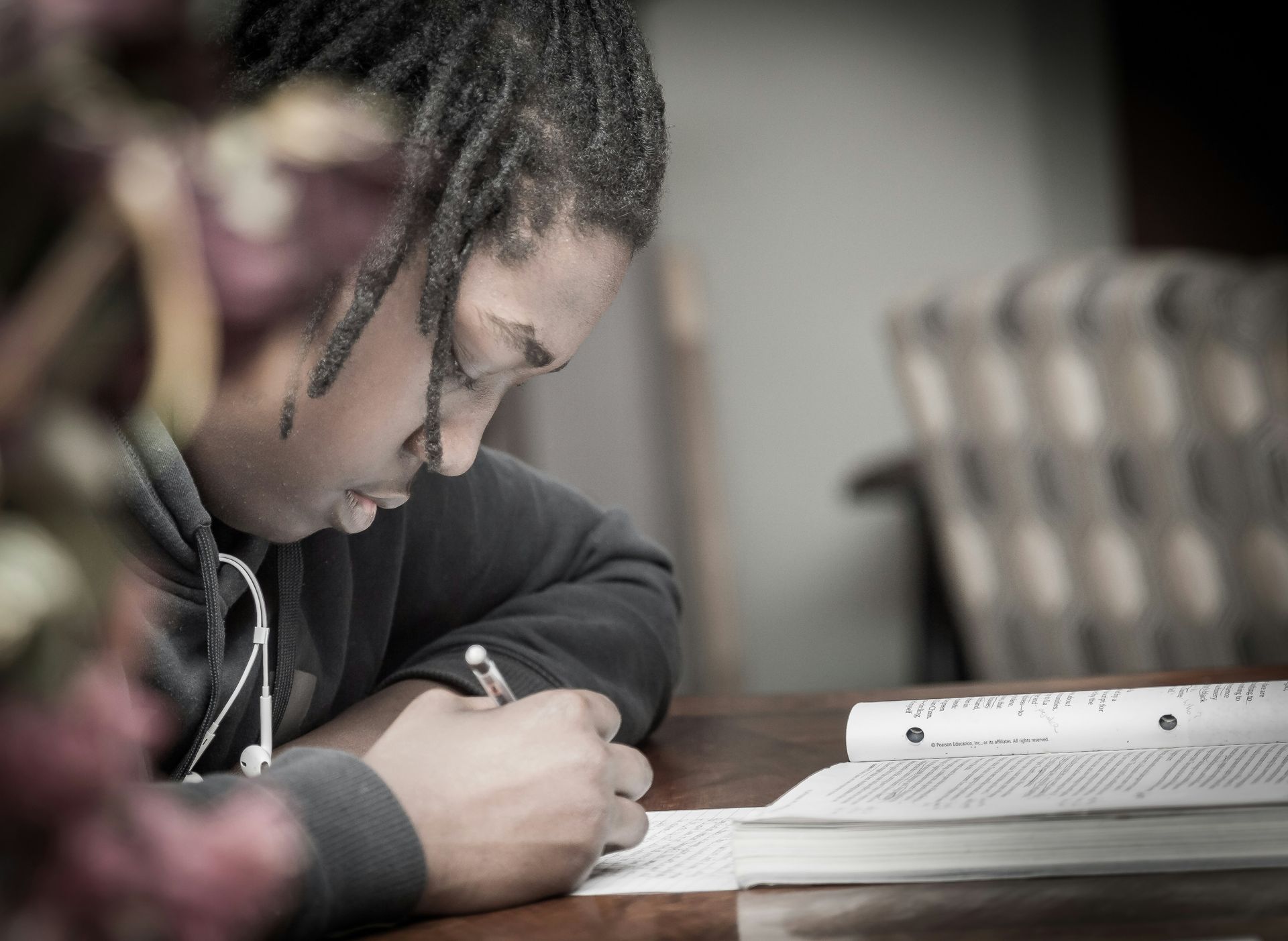BLOG

If you’ve ever wondered how we can help our kids face the pressures of school, home life, and their ever-growing social circles, you’re not alone. Our kids today are juggling a lot—whether it’s keeping up with homework, fitting in with friends, or dealing with the everyday stress of growing up. And while it’s important to equip them with practical skills and emotional support, there’s one superpower that often gets overlooked: the joys of reading and writing . Jonathan Douglas, the Director of the National Literacy Trust, says it best: “Children and young people today face a multitude of pressures at school, at home and in their social lives. It is imperative that we do everything we can to enable our children to develop the resilience they need to cope with life’s challenges – and our latest research shows that the joys of reading and writing can be hugely beneficial. Not only does a love of reading and writing enable children to flourish at school, but we now also know it can play a vital role in supporting children to lead happy and healthy lives.” It turns out that something as simple as cracking open a book or scribbling in a journal can do wonders for helping kids cope with the ups and downs of life. Let’s break down why reading and writing might just be the most underrated tools for building resilience in kids today. Reading: The Escape and the Strength Think of reading as a mini-vacation for the mind. When kids dive into a good book, they can temporarily escape from their own challenges and immerse themselves in a different world. Whether it’s escaping to Hogwarts or going on an adventure with a young detective, books let kids experience new perspectives and build empathy as they walk in the shoes of characters from all walks of life. But it’s not just about getting lost in a story. Reading also teaches kids problem-solving skills. In many stories, the characters face challenges and have to think creatively to overcome them. When kids read, they’re subconsciously learning how to face their own problems in real life—whether it’s handling a tricky situation with a friend or figuring out how to manage a stressful exam. Writing: A Safe Space to Let It All Out Now, let’s talk about writing. Whether it’s journaling, creative writing, or just putting their thoughts on paper, writing gives kids the chance to express their feelings, frustrations, and ideas in a safe and private way. Writing helps them make sense of their emotions and experiences, which is key to building resilience. When kids have a safe space to let off steam, they’re less likely to bottle things up, which can lead to stress and anxiety. In fact, research shows that writing about feelings—whether through a diary or even writing letters to themselves—can reduce stress and help kids gain clarity on their emotions. It’s like giving them a mental toolkit to cope with whatever life throws their way. How Reading and Writing Help Kids Build Resilience They Gain Confidence Kids who read regularly often become more confident learners. The more they read, the better they get at understanding complex ideas and expressing themselves. This boosts their confidence in school and in social situations, helping them navigate the ups and downs of their daily lives with more resilience. They Develop Emotional Intelligence When kids read stories with strong emotional arcs, they learn how to identify and manage their own emotions. They see characters dealing with challenges, facing fears, and finding hope. These experiences help children understand that setbacks are a normal part of life—and they can handle them. They Learn to Problem-Solve Both reading and writing encourage critical thinking. In books, characters are often faced with tough decisions and must figure out how to resolve conflicts. By following these journeys, kids learn to apply similar strategies to their own lives, developing problem-solving skills that make them more resilient in the face of adversity. They Build Empathy Reading opens up new worlds and diverse perspectives. Kids who read about different cultures, backgrounds, and experiences develop empathy. They begin to understand that everyone faces challenges—and that’s something they can relate to. This sense of shared humanity is a huge part of developing resilience. Wrapping It Up: A Love for Reading and Writing Is the Gift That Keeps on Giving So, the next time you’re looking for ways to help your child build resilience, consider introducing them to the world of books and writing. It’s not just about improving grades or boosting vocabulary (though those things are awesome, too!)—it’s about giving them the tools to navigate life’s challenges with confidence and strength. Jonathan Douglas’ insight is a powerful reminder that reading and writing aren’t just academic skills. They’re essential to helping kids grow into emotionally healthy, well-rounded individuals. And who knows? That next adventure in a book or the journal entry they write could be the exact thing they need to feel empowered to face whatever comes next. Let’s make sure we’re giving them every opportunity to flourish, both in and out of the classroom.

Okay, parents—let's talk about something that’s probably crossed your mind at least once: your kid’s reading struggles. Whether it’s that sigh of frustration when they can’t make it through a book or that look of pure confusion when they come across a tricky word, we’ve all seen our kids go through some serious reading challenges. I often tell the story about how our youngest son was turned off by reading during his early elementary years, but he had a passion for writing. We often found him in his room, letting his creative young mind run wild, writing short stories or short movie scripts—his favorite. I did not know this at the time, but the thing is: one of the easiest ways to help them become better readers isn’t by pushing them to read more—it’s by getting them to write. Yes, you heard me right. Writing can actually boost your kid’s reading skills. Sounds too good to be true, right? Let’s dive into it. Writing Makes Reading Less of a Mystery Here’s a little wisdom from Colleen Cruz, author of “Writers Read Better,” who knows a thing or two about literacy: "...if something is challenging to a reader, one of the most accessible paths to overcoming that challenge is through writing." In other words, when kids are struggling to read or understand a passage, sometimes the best thing to do is not force more reading on them but to encourage writing . Writing helps kids make sense of words, sentence structure, and the flow of ideas in a way that just reading doesn’t always do. It’s like they’re building the framework for reading in their brains, brick by brick. Pretty neat, right? Think of it like this: when you’re assembling furniture, you can stare at the instructions all day and still have no idea how that bookshelf is going to look in the end. But once you start putting those pieces together—once you build it—it starts making sense. The same goes for writing and reading. Writing helps them understand the “pieces” of language, like punctuation, vocabulary, and sentence structure. So when they go back to reading, they see how all those pieces fit together to make sense. It’s like unlocking a secret reading cheat code. The Magic of Writing Early and Often But wait, it gets better. According to Pam Allyn, a literacy expert and all-around reading guru, writing early and often is a "powerful lever for helping our students learn to read profoundly." Now, you might be wondering, “Does this mean I have to force my child to write five pages every night?” Absolutely not. But regular writing—whether it's journaling, creative stories, or even silly notes to their friends—helps kids develop a deeper understanding of language. When kids write regularly, they get to experiment with how words look, sound, and feel on the page. They learn about spelling and grammar without even realizing it. And when they see how words come together to form sentences and stories, it helps them recognize those same patterns when they’re reading. It’s like getting to practice the moves in a dance before you have to perform the routine in front of an audience (aka reading comprehension tests). The more they write, the more their brain is geared up to tackle reading. It’s All About Confidence Okay, so why does writing help with confidence? Simple: writing is a safe space . It’s where kids can mess up, cross things out, and get creative without the fear of judgment or failing. When they write, they’re practicing making sense of their thoughts, and that translates into reading. If your child is confident in their ability to put words together on the page, they’re more likely to have confidence when they face tricky words or complex sentences in a book. Writing gives them a tool to fight back when reading feels overwhelming. Plus, there’s something about expressing their own ideas through writing that makes reading feel less intimidating. Instead of seeing reading as a mountain to climb, writing lets them practice being on the “other side” of the mountain—knowing that they’re in control and can figure things out, one word at a time. Writing = Reading Superpower Look, as parents, we don’t want to be the “pushy” ones, constantly nagging our kids to read more. But encouraging writing? That’s something they can enjoy while sneaking in some reading practice without even realizing it. Whether it’s writing short stories, keeping a journal, or even composing letters to their favorite characters, it all helps. And if you're wondering, “How do I get them to write without it feeling like a chore?” Well, start small. Let them write about what they love—whether it’s about their favorite video game, the weird dream they had last night, or maybe they enjoy creating movie scripts like our son did. The key is to make writing fun —because the more they write, the better readers they’ll become. And who doesn’t want to have a little fun while becoming a reading ninja? In Conclusion... So, next time your kid’s struggling to get through a chapter, try handing them a notebook and saying, “Hey, want to write about your day or invent a new superhero?” It’s like the ultimate two-for-one deal: more writing = better reading. According to Colleen Cruz and Pam Allyn, writing isn’t just a sidekick to reading; it’s the superhero cape that helps kids soar to new literacy heights. Plus, you’ll be the parent that can proudly say, “I’m not just making them read—I’m making them write their way to success.” Now, that’s some parenting power!

Alright, parents, teachers, and anyone who has ever seen a child build a fortress out of couch cushions—I don’t know about you, but coming home and seeing this drove me crazy when my children were little. But guess what? It’s how creative kids learn. Spoiler alert: It’s not always about worksheets and spelling tests. In fact, it’s more like watching a tiny tornado of ideas and energy spin and develop. If you've ever been around a kid who’s bursting with creativity, you know it's a whole vibe. These kiddos don't just learn—they experience learning. They don't want to just read about a forest; they want to climb the trees, hug the squirrels, and probably dress up like a tree themselves for an impromptu performance. For them, learning is less about memorizing facts and more about creating something that has never existed before . 1. Trial, Error, and a Little Chaos A creative child doesn't just pick up a pencil and color inside the lines like a little robot. Oh no, they’ll start with the pencil, then probably get distracted by the texture of the paper. Maybe they’ll draw an entire castle, and then decide halfway through that it’s now a spaceship. (Somewhere, their teacher’s soul cries a little, but it’s okay, we’re learning in the process!) Creativity thrives on trial and error. "Oops, this didn’t work—let’s try again!" is their unofficial motto. Instead of getting frustrated, these kids see mistakes as opportunities to pivot, adjust, and invent something cooler. After all, the greatest inventions weren't built on perfect plans—they were built on a lot of “well, that didn’t go as expected” moments. 2. Learning Through Play (aka "The Serious Business of Fun") If you think playtime is just for goofing off, you’re missing the point. Creative children use play as their secret weapon. While you might think they’re simply pretending to be pirates (spoiler: they are), they’re actually learning how to navigate complex systems, solve problems, and negotiate with their fellow pirates (a.k.a. their little brother who insists on being the captain). Imagine a kid who builds a Lego spaceship. They don’t just follow the instructions (boring!). They build a spaceship, then a whole galaxy, then maybe a racetrack for alien cars, and suddenly, they're learning about spatial reasoning, engineering, and... a deep love for intergalactic travel. It’s all in a day's work for a creative mind. 3. The Power of Curiosity Creative kids are like little scientists in disguise. Ask them a question, and they'll probably ask 10 more. “Why is the sky blue?” turns into “Can I eat the clouds?” “How do trees grow?” morphs into “Can I grow a tree that reaches the moon?” Their curiosity isn’t just about seeking answers; it’s about diving headfirst into the process of discovery. The joy isn’t in the conclusion (though they might be a little excited about that too); it's in the never-ending journey of exploration. For them, the world is a mystery waiting to be solved—and they’ll solve it one curious question at a time. 4. The Power of Imagination (And Having a Ridiculously Good Time) One of the greatest gifts of a creative mind is the ability to imagine new worlds. For a creative kid, every cardboard box is a spaceship, every chair is a throne, and every blanket is a portal to another universe. The imagination knows no limits, and neither do they. Learning through imagination is like attending a class on everything at once. Whether they’re pretending to be a medieval knight solving puzzles or a detective cracking codes, they’re learning how to think critically, organize ideas, and make connections—all while being really, really entertained. And honestly, isn’t that how we all learn best? 5. Collaboration Over Competition A creative child doesn't just want to learn alone—they want to share their ideas and make something together. They’re the ones organizing the group art project, the ones who say, “Hey, let’s build a treehouse that can also double as a movie theater.” Teamwork makes the dream work, right? For them, collaboration is a learning tool in itself. By bouncing ideas off each other, working together on a project, or helping each other solve problems, they learn empathy, communication, and the fine art of compromise. It's not just about getting to the end result; it’s about the process of building it together—and probably laughing a lot along the way. Final Thoughts: Learning is Everywhere So, next time your creative child decides to turn the living room into an art gallery or creates a multi-level fortress out of old magazines, remember this: They're learning. They may not be following the “rules,” but they’re discovering new ways to think, solve problems, and bring their ideas to life. While the world may sometimes value structure and order, creative kids know that the best lessons are learned in the chaos, the mess, and the endless exploration. And let's face it: If learning can be this fun, who wouldn’t want to join in?
